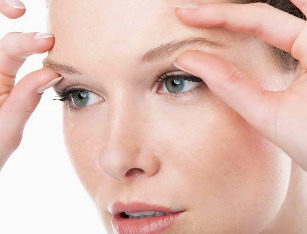
Lifting the eyelids is a complex of injections and manual manipulations aimed at rejuvenating and modeling the periorbital region (around the eyes). This part of the face is considered an area of increased sensitivity, so the correction of non-surgical aesthetic eyelids is such a difficult task for a highly qualified specialist with extensive experience. Microsurgical cosmetology and aesthetic medicine today offer several effective methods to lift the eyelids: radio wave lifter, bio-reinforcement with ropes, contour plastic, photorejuvenation, microwave therapy. You can choose the most appropriate technique only after a visual examination of the problem area, the patient's anamnesis, goals and opinions about what the end result will be.
Periorbital lifting features
The region of the eyelids, also called the periorbital zone (which is not entirely true because the lacrimal apparatus, palpebral fissure, and conjunctival sac also belong to the periorbital space in addition to the eyelids) is one of the most sensitive areas of the human body with a thin layer of dermis. subcutaneous fat. These are muscular wrinkles limited to the eyelids, conjunctiva and cartilage tissue. They are around the eyes and simultaneously perform several functions: protect the cornea and retina from the negative effects of the environment (ultraviolet radiation, dust, etc. ), clean the connective tissue membrane due to constant hydration, 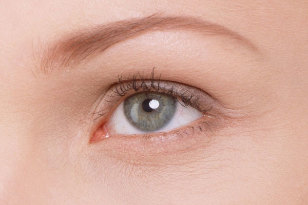 Prevents dry eye sclera. and cornea.
Prevents dry eye sclera. and cornea.
Because the skin in the eyelids is several times thinner than other parts of the face, it is more prone to age-related and stressful changes, which are noticeable to most people after 30 years. At this age, the body's natural dehydration process begins, resulting in epidermal cells losing moisture and skin losing elasticity, loosening and sagging. The first signs of aging occur in the periorbital zone in men and women over 30 years of age: hypodynamic wrinkles, facial wrinkles, wrinkles in the outer corners of the eyes ("crow's feet").
Lifting the eyelids is a complex task that should be performed only by a highly qualified physician who knows the topographic anatomy of the eye, because incorrect movements can not only lead to new defects, but also seriously impair the functioning of the visual organs. The fact is that the eyelids are involved in the formation of eye focus and corneal optics and the regulation of intraocular pressure, so improper plastic surgery and lifting can lead to impaired vision (in some cases irreversible).
Who needs to lift the eyelid
There are no serious medical indications for the removal of the periorbital area (except for surgical correction, which is often used in the treatment of pathologies that interfere with the normal functioning of the visual organs) and is performed at the patient's request to eliminate visible aesthetic defects. Cosmetologists and plastic surgeons include the following disadvantages:
- strong protrusion of the supraorbital layer;
- excess skin in the infraorbital musculature;
- sagging of the outer corners of the eyes;
- periorbital protrusions (fat hernias);
- periorbital edema (sacs);
- vascular pathologies that cause the formation of traces of rosacea and dark circles under the eyes;
- hypodynamic wrinkles;
- "crow's feet" (wrinkles in the corners of the eyes);
- strongly expressed infraorbital threads;
- "aging eyelid" (fading and varnishing of the eyelid skin).
The eyelid lift helps to create a fresher and clearer look by correcting sagging skin and periorbital fat sacs and improving the overall tone of the area.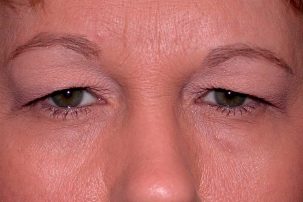 Timely use of various methods to rejuvenate the eye area helps to solve one of the main tasks of periorbital lifting - to hide age-related changes in the skin and get rid of visual defects inherent in the biological aging of the dermis against the background of reduced functional capacity of epidermal cells.
Timely use of various methods to rejuvenate the eye area helps to solve one of the main tasks of periorbital lifting - to hide age-related changes in the skin and get rid of visual defects inherent in the biological aging of the dermis against the background of reduced functional capacity of epidermal cells.
Important! Aging and heavy eyelids is a very serious aesthetic defect that can ruin even a young and attractive face. For some, signs of skin aging in this area may appear before the age of thirty (for example, in overweight patients or in a person with endocrine system pathology). As a rule, cosmetics are ineffective in correcting existing problems and are only suitable for preventing premature aging, so the only effective way to combat this defect is to lift the periorbital.
Eyelid lifting operation
Surgery to lift the skin on the upper and lower eyelids is called blepharoplasty. This is a kind of radical removal of the periorbital area, where the effect of compression and rejuvenation is achieved by completely removing excess skin and fatty tears in the eyelid area.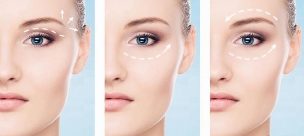 Unlike non-surgical methods of eyelid lifting, blepharoplasty allows not only to correct aging skin defects and improve the appearance of this area, but also to correct the shape and form of the eyes, as well as get rid of various pathologies.
Unlike non-surgical methods of eyelid lifting, blepharoplasty allows not only to correct aging skin defects and improve the appearance of this area, but also to correct the shape and form of the eyes, as well as get rid of various pathologies.
Blepharoplasty is effective for serious ophthalmic diseases such as entropion (protrusion of the eyeball on the eyelashes and at the edge of the eyelid) or exophthalmos (displacement of the eyeball outside the orbit). In general, there are three types of blepharoplasty: upper, lower and circular.
table. Types of radical periorbital lift
| Type of operation | Section area | What pathologies can be corrected |
|---|---|---|
| Supraorbital blepharoplasty | A section of skin in the orbital or tarsal layer of the upper eyelid. | Removal of excess skin, subcutaneous fat and muscle plastic. |
| Suborbital blepharoplasty | A transcutaneous or subcutaneous incision is made. | Elimination of periorbital edema, bags under the eyes, fatty tears. |
| Circular blepharoplasty | Simultaneous eyelid surgery on both sides. | Solving problems common to all types of blepharoplasty. |
Periorbital compression surgery is performed in a hospital setting, except for the possibility of an outpatient procedure. The patient is given general anesthesia and the duration of the intervention is approximately 3 hours on average. Although a significant disadvantage of this method for lifting eyelids is the short postoperative period, which is characterized by pain, the need for regular dressings and antiseptic treatment, and significant limitations in regimen and professional activity, although short (about two weeks).
Important! The advantage of surgical blepharoplasty is not only to tighten the skin of the eyelids, but also to perform plastic surgery on muscle tissue, which can not be achieved using apparatus and other minimally invasive methods.
Periorbital compression without surgery
Surgical removal of the eyelids is an extremely effective method of radical rejuvenation around the eyes, but experts recommend only patients in the older age group (after 40 years) with obvious signs of aging and deep age-related skin changes. While the hydrodynamics of tissues before this age are normal, there are less traumatic ways to correct existing problems, and the effectiveness of most of these techniques can be compared to the outcome of surgical plastic surgery.
Injection (contour) plastic
Contour plastic surgery is perhaps the most reliable method of non-surgical removal of eyelid skin due to techniques related to mesotherapeutic procedures. Contouring is a subdermal injection of special implants called fillers.
These are preparations in the form of a homogeneous and viscous suspension or gel based on components that are highly close to the body's own tissues. These can be:
- hyaluronic acid;
- calcium hydroxyapatite;
- collagen (a peptide synthesized by fibroblasts and one of the main elements of the extracellular substance of the dermis, providing elasticity and elongation);
- polymers based on acrylic and methacrylic acid;
- high molecular weight oxygenated silicone;
- polylactic acid;
- tripolyphosphoric acid salts, etc.
The most popular and required fillers for lifting periorbital are hyaluronic acid-based preparations. These are biodegradable dermal implants that help to eliminate wrinkles while compensating for the lack of tissue in the area. The advantages of hyaluronic fillers are high hypoallergenicity and excellent results, which can be assessed immediately after implantation. Bioresorption of hyaluronate occurs within a few weeks, after which injections should be repeated.
Biosynthetic implants based on polylactic acid and calcium hydroxyapatite retain their properties for 1-2 years.
RF lifter
Radiofrequency ablation is a non-surgical removal of the eye area that is highly effective.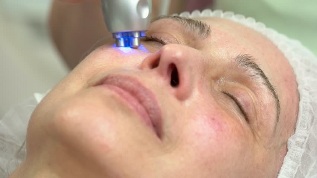 RF lifting is one of the leading techniques for minimally invasive lifting of the skin of the upper and lower eyelids, as it not only achieves an immediate compression effect, but also significantly improves the condition of the skin in the periorbital area.
RF lifting is one of the leading techniques for minimally invasive lifting of the skin of the upper and lower eyelids, as it not only achieves an immediate compression effect, but also significantly improves the condition of the skin in the periorbital area.
Radio waves penetrating the dermis to the required depth heat the epidermal cells to a collagen compaction temperature of about 60 ° C. Under the influence of thermal energy, the dermal tissue is heated, the collagen frame is partially retracted, as a result of which the free collagen fibers are re-compressed and take the characteristic spiral shape with a lifting effect.
RF lifting is suitable for correcting all age-related problems around the eyes (crow's feet, hypodynamic wrinkles, eyelid ptosis, etc. ) and the result lasts up to 1-2 years. You should do about 6-10 procedures at least 7-10 days apart to get a stable rejuvenating effect.
Bio-reinforcement with ropes (rope lifting)
Thread lifting is a procedure to rejuvenate the area around the eyes based on the placement of special cosmetic threads made of different metals and synthetic materials under the skin, resulting in the formation of a new collagen framework in the subdermal layers. The procedure is quite effective and allows you to cope with the problem of "aging age", oily periorbital hernia, the phenomenon of gravity ptosis and other phenomena characteristic of aging skin.
There are several types of yarn to lift the rope. Yarns made of precious metals are in great demand in cosmetology. These threads are made of platinum or gold and are designed to strengthen the upper layers of the dermis. Golden threads not only give a visible lifting effect, but also stimulate cell metabolism, improve the supply of nutrients, oxygen and vitamins to dermal cells. Serious disadvantages of yarns made of precious metals are the high risk of separation and the impossibility of using many cosmetic procedures, such as photothermolysis after hardening.
Liquid mesothreads are mainly used to combat small hypodynamic wrinkles, correct "aging eyelids" and smooth the skin in the periorbital area. The duration of such a procedure does not exceed 20-30 minutes, but there are many contraindications to strengthening with liquid ropes, and it is always accompanied by various side effects (swelling, bruising, redness). Experts believe that the most effective types of lifting eyelid ropes are Swiss, polylactic and Korean ropes. After such strengthening, the result lasts for about 2-3 years.
Fractional photothermolysis
Fractional photothermolysis is another effective method of non-surgical skin compression of the upper and lower eyelids. This is a type of laser rejuvenation that uses a fractional laser generator (such as an erbium laser) to affect the problem area. The radiation generated by this device is scattered in many streams and when it touches the skin, it forms a large number of microthermal treatment zones, where the main effect also occurs, so the surrounding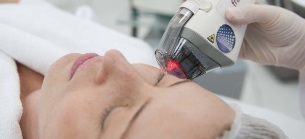 tissues do not heat up and are not damaged.
tissues do not heat up and are not damaged.
A distinctive feature and at the same time the main principle of operation of fractional photothermolysis is the heating of the skin at a temperature of 250-300 ° C, which experts call the evaporation procedure. Under the influence of this temperature, old, pathologically altered and destroyed cells are destroyed and evaporated, and natural neocollagenesis is activated, and the activity of fibroblasts that synthesize the main components of the extracellular matrix - peptides (collagen and elastin) increases.
Fractional laser surface treatment results in severe compression of the skin on the eyelids, correction of wrinkles and creases, restoration of hydrodynamics of periorbital tissues and improvement of the general condition of the skin in this area.
Pulse currents (micro currents)
Microwave therapy is a low-traumatic method of lifting the eyelids, but a significant disadvantage of this method is the short duration of the result (not more than 4 months). The clinical outcome of the use of microcurrent therapy to lift the periorbital area depends on the following characteristics of pulse currents:
- Normalization of lymphatic drainage. Lymphatic drainage effect, which has impulse currents in the skin, improves lymphatic movement, prevents stagnation and helps to illuminate the dark circles under the eyes;
- Stimulation of metabolic processes.Activation of cell metabolism has a positive effect on the transport of oxygen and nutrients and the appearance of the skin (skin becomes smoother, a healthier appearance);
- Restoration of muscle tone.The eyelid muscles are quite weak, and additional stimulation allows you to achieve a tightening effect.
The standard course duration is between 10 and 20 procedures, in most cases the procedure needs to be repeated after a few months.

Before and after photos
Result
Lifting the eyelids is a difficult but possible task, modern aesthetic medicine offers very few effective methods to solve it, low traumatic manipulations with low probability of complications. Which method of periorbital removal is most effective and safe is decided individually after talking to the patient, diagnosing the problem area and examining the medical history.
The use of surgical methods is indicated mainly for patients with mild signs of aging around the eyes, the use of gentle techniques is ineffective and does not give a stable positive result. People with the initial manifestations of "aging" are better off choosing minimally invasive methods with less tissue trauma and a shorter recovery time.
























































